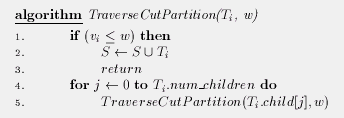
Clearly S defines a partition of the dataset E. We may then vary the level-of-detail (LOD) in our data display by changing the control parameters that control the location of S.
Any variable that varies S is a candidate for the LOD control parameter. For instance, the tree depth is one conceivable discrete control parameter. However, it is a poor choice in some cases because the number of nodes increase dramatically with depth. This manifests as abrupt screen changes as the LOD switches values at higher depths of the tree.
We desire a continuous LOD control parameter that provides smooth transitions on our data display. We define:

Note that S(vmax) is a single partition comprising the entire E, while S(vmin) is a partition consisting of all the leaf nodes of T.
The following algorithm finds the elements of S(w) in a recursive top-down manner:
